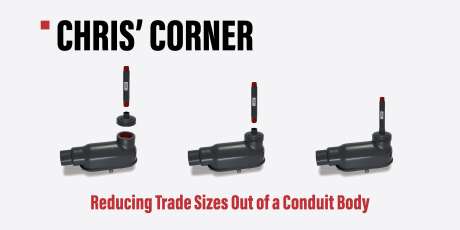
Question
What is the correct way to reduce my run from 1” to ¾” out of a condulet body? How can I make this transition while keeping the system completely sealed?
Answer
This is a great question, and it’s one that we encounter often. First, some context: in almost all instances, when working with PVC-coated materials, it’s important to make sure that the sealing sleeves on all products remain intact. These integral sleeves provide maximum protection of the threads from ingress of water, dirt, and other contaminants that can lead to corrosion.
Using a standard reducing bushing might seem like the correct way to transition between trade sizes out of a condulet body; however, doing so leaves a gap between the sealing sleeve of the conduit hub and the smaller trade size conduit where water and chemicals can collect and ultimately cause the system to fail over time. Removing the sealing sleeve in this case doesn’t fix the issue, either. The reduction can be made, but that tight seal is eliminated and the threads remain exposed, compromising the environmental integrity of the installed system. Plus, it just doesn’t look professional.
Traditionally, to make this transition, I would’ve told you to use a short nipple coming out of the female conduit hub and then a reducing coupling to move down to a smaller trade size conduit. The reducing coupling is female-to-female with sealing sleeves on both ends, and by using this instead of a standard reducing bushing, you can ensure that there are no gaps or voids and that no threads are exposed. This is a perfectly fine solution that has worked for ages; however, it adds extra length and material cost to an installation that may or may not be able to accommodate it.
So, Plasti-Bond created a new solution that saves space, installation time, and cost while still maintaining a sealed system: the PVC-Coated Reducing Bushing with Sealing Sleeves. This new, patent-pending product features an integral bushing with sealing sleeves on both ends to accommodate the change in trade sizes, allowing you to reduce down directly out of the condulet body. And though I previously stated that in most instances the sealing sleeves of PVC-coated products should not be removed, this innovation actually requires the installer to completely remove the sealing sleeve from the female conduit hub of the condulet body. Doing so enables the PVC-Coated Reducing Bushing with Sealing Sleeves to fit snuggly around the outer diameter of the conduit hub and reduces the amount of space the transition takes up. From there, the smaller trade size conduit can be installed, creating a sealed connection that reduces the risk of moisture ingress while maintaining the installation’s sleek, professional look. No exposed threads, no weak links, no corrosion concern.
These PVC-Coated Reducing Bushings are absolutely what I would recommend for you to use in your case. They come in 15 different configurations of trade sizes to adapt to whatever circumstances you may encounter, and they will keep your system completely sealed without the added worry of increased transition length or material cost. You can learn more by watching the video below or by reaching out to csr@robroy.com.